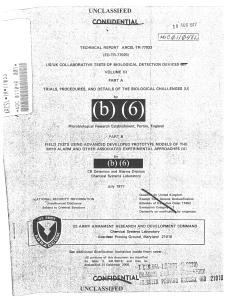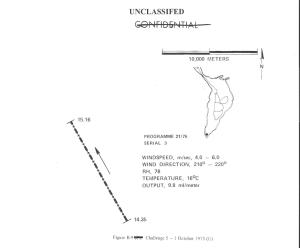FAQs: The 1975 Dorset Joint UK/US Biological Detection Experiments
1. Who was involved?
Military scientists from the Microbiological Research Establishment (MRE), Porton Down, and the US Biological Defense Branch,Development and Engineering Directorate, Edgewood Arsenal.
2. What happened?
A series of 24 field trials took place off the coast of Portland and in Lyme Bay. Each field trial involved the spraying of massive bacterial aerosols from a converted Land Rover, which was strapped to the deck of Fleet Tender COCKCHAFER. Each trial sprayed a suspension of: one type of live bacteria: and, one type of ‘inactivated’ bacteria.
These were:
Bacillus globigii (BG, aka Bacillus subtilis); and,
Inactivated Serratia marcescens (ISM)
The trials procedure was for the ship to sail upwind of the target area (the AUWE compound at Portland Bill), all the time spraying the bacterial suspension. This resulting aerosol would be carried downwind and over the sampling site, where it would hopefully be detected by the sampling device under test – the US developed XM19 Chemiluminescence Detector.
Obviously, given the amount sprayed, each bacterial aerosol would have been transported past the target area and would have travelled many tens of miles downwind from the source vessel. Results obtained from similar previous field trials, conducted by MRE Porton in the Dorset area during the 1960’s, proved that the bacterial aerosols would remain viable (live) and in a significant concentration, even after downwind travel of 40+ miles. The fact that one type of bacteria used in the 1975 DICE Trials, Bacillus globigii (BG), was sprayed in spore form would have enabled it to survive long distance travel – even in the presence of adverse environmental conditions, such as sunlight.
3. When were these trials conducted?
During the period, 29 September 1975 and 24 October 1975. On a number of occasions up to three separate field trials were conducted during a single day. Field trials were conducted during daylight and the hours of darkness.
Fleet Tender COCKCHAFER sprayed the bacterial suspensions on the following dates/times (click on dates to view the relevant trials map):
- 29 September 15:35 -15:55
- 30 September 12:19 – 12:40
- 30 September 13.03 – 13.23
- 30 September 13:55 – 14:16
- 01 October 14:35 – 15:16
- 01 October 15:40 – 16:21
- 01 October 17:10 – 17:52
- 03 October 14:07 – 14:27
- 03 October 15:44 – 16:12
- 03 October 16:35 – 17:17
- 06 October 13:10 – 14:13
- 13 October 22:30 – 22:57
- 13 October 23:51 – 00:19
- 15 October 18:90 – 19:02
- 17 October 12:21 – 12:55
- 17 October 13:21 – 13:55
- 18 October 16:45 – 17:19
- 19 October 18:57 – 19:24
- 19 October 20:16 – 20:37
- 19 October 21:11 – 21:33
- 21 October 12:18 – 12:50
- 21 October 13:28 – 13:56
- 21 October 14:27 – 15:02
- 21 October 15:28 – 15:55
4. Where were the 1975 trials conducted?
Lyme Bay and Weymouth Bay – often, as can be seen by some of the trials maps (see example below), extremely close to the Isle of Portland – the closest ever seen throughout the entire Lyme Bay trials period (1963-1975).

5. Why were these trials conducted?
Long story, short. The results of public area field trials conducted in the early-mid fifties proved the feasibility of the long distance travel of particulate aerosols. In 1957, both Porton Down research facilities – the Chemical Defence Experimental Establishment (CDEE) and the Microbiological Research Establishment (MRE) Porton Down co-produced a new theory concerning the conduct of future Chemical and Biological warfare – the Large Area Coverage (LAC) concept.
After conducting a series of long-range LAC field trials, involving the widespread aerial spraying of a hazardous cadmium compound (Zinc Cadmium sulphide – ZnCds) across vast swathes of England and Wales, Porton Down scientists proved that a single aircraft, flying a single sortie, could contaminate an area greater than 10,000 square miles!
A declassified document (minutes of the 41t Meeting of the Biological Research Advisory Board) from the late 1950’s reported that the second trial covered a population of 28,000,000 with an estimated respiratory dose of the order of 100 particles – according to the results obtained from USA experiments, that a 50% effective human dose of the BW agents P. Tularensis and Cox. Burneti was well under 100 micro-organisms.
The results from the Large Area Coverage ZnCds experiments greatly alarmed the Chiefs of Staff, and eventually led to MRE being tasked to conduct the Lyme Bay Trials in South Dorset in order to discover the feasibility of conducting Biological Warfare, and to investigate a method of detection of airborne clouds of BW agents. By 1966, results from the Lyme Bay Trials had proved that an appreciable dose of viable (live) bacteria could be achieved over an area greater than 1,000 square miles by the release of only 120 gallons of bacterial suspension. The conduct of biological warfare had finally been proven feasible.
In the late 1970s, the UK military issued Naval General Air Staff Target 3083, which charged MRE Porton Down to conduct a feasibility study concerning the development of a BW detection system. In 1971, the UK collaborated with the US in a series of NGAST 3083 related collaborative field trials. 16 of these trials were held in Dorset in November 1971, and involved the repeated release of massive aerosols of ISM and live BG.
In 1975 it was decided to test, in field conditions, the BW detector most likely to be adopted by the UK for NGAST 3083 – the US developed XM19 Biological Agent detector.
By 1976, one year before the results of the 1975 UK/US trials had been published, UK military chiefs decided not to support further research for a network of BW detectors and NGAST 3083 was abandoned.
In 1983, the US finally abandoned research and development of the XM19 – too many false results.
6. Were the bacteria used in the 1975 DICE Trials harmful?
The declassified US report reveals that the bacterium Serratia marcescens was inactivated before being sprayed over South Dorset, hence the name Inactivated Serratia marcescens. This material was produced for the 1975 DICE Trials by scientists from the MRE Porton Down.
The second type of bacterium used in the DICE Trials was Bacillus globigii (BG), which is now considered to be a pathogen in humans – i.e. capable of causing disease in susceptible individuals; such as those who are immuno-compromised, undergoing surgery, wound trauma, the very young, the old, etc.
See Biological Warfare (BW) Simulants – Bacillus globigii (BG)
7. Did MRE Porton Down obtain specific Government permission to conduct the 1975 DICE trials in populated areas?
No.
In reply to a recent Freedom of Information request, which asked for details of the prior authority (including Ministerial permission), obtained by MRE Porton Down, to conduct the third phase of the 1975 Dice field trials in areas open to the public, Dstl (MRE’s successor organisation) stated:
“…the only identified authority that Dstl are aware of for approval of the use of live non pathogenic simulants in the field is the 1961 Biological Research Advisory Board (approval) for such use in trials which might involve exposure of members of the public, (apparently) an approval for the use of any living non pathogen subject to rigorous testing of every batch in animals and the 1969 BRAB approval, subject to the same rigorous testing, but specifically for E.coli MRE 162.”
In other words, as far as Dstl Porton Down are aware, no official Government permission was either sought or granted for any of MRE Porton Down’s public area Biological Warfare experiments, other than the granting of ‘approval’ by the Biological Research Advisory Board (BRAB); a committee which, as we have already discovered, had no power of veto and could only offer MRE Porton Down advice – advice which, unlikely as the possibility may seem, the Director of MRE Porton Down could choose to ignore.
8. Were this series of 24 Biological Warfare experiments examined by Prof. Spratts’ MOD commissioned Independent Review?
No.
For reasons which remain unclear, the Ministry of Defence (and Porton Down) did not provide details of the joint 1975 UK/US DICE Trials for inclusion in the Independent Review of the Possible Health Hazards of the Large – Scale Release of Bacteria During the Dorset Defence Trials , which was produced for the MOD in 1999, by Professor Brian Spratt FRS.
9. Now the Cold War is over, do the Ministry of Defence rule out conducting similar Public Area Biological Warfare experiments in the future?
The Ministry of Defence currently refuse to rule out conducting similar BW experiments in populated areas in the future.
On 15 June 1999, the Defence Evaluation Research Agency (DERA) replied to an inquiry* which requested information concerning the future conduct of BW experiments in populated areas.
DERA replied:
“In the event of a military question arising which could only be answered by conducting open air trials in areas which may involve the general public, Ministers have made it clear that they cannot rule out the need to conduct larger scale trials in the future to try to ensure the protection of the UK from attacks by people of states using biological or chemical weapons.”
*DERA reply to a Code of Practice on Access to Government Information request 15 June 1999 (DERA/SEC/5/13/100/99)
It is vital to understand that this is the first occasion that any UK Government has ever made it’s public area CBW experiments policy known to the public. They openly admit that it is official Government policy to conduct larger (larger?) scale BW experiments over populated areas, should there be considered to be a military need.
Two years after this policy entered the public domain, a military question arose – since the events of 11 September 2001 two of the Tripartite countries (US and UK) have massively increased their BW research capabilities. The US has spent enormous sums of money on BW research, and in the UK, the Ministry of Defence CBW research facility at Porton Down has expanded beyond recognition.
How long it will be before either organisation decide that the time has come to repeat their Cold War public area BW experiments is open to speculation. As is the question of whether the general public would be informed of any proposed large-scale series of trials – would they again be held in complete secrecy?
In 2006 Dstl Porton Down admitted that the 1999 Government policy was still operational (FOIA reply from Dstl Porton Down 06 June 2006), but they added that they had not as yet needed to conduct any large-scale BW field trial in populated areas.
Whether they have felt a need during the past two years is not yet known, but it is certain that the recent conflict between Georgia and Russia has once again raised the spectre of a resurgent Russia – a nation capable of conducting large-scale BW operations, should they so wish.
It is therefore entirely possible that the MOD will at some time in the near future deem it necessary to recommence their programme of large-scale BW experiments in populated areas.



